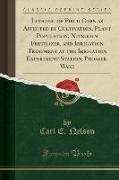Lodging of Field Corn as Affected by Cultivation, Plant Population, Nitrogen Fertilizer, and Irrigation Treatment at the Irrigation Experiment Station, Prosser, Wash (Classic Reprint)
BücherAngebote / Angebote:
Excerpt from Lodging of Field Corn as Affected by Cultivation, Plant Population, Nitrogen Fertilizer, and Irrigation Treatment at the Irrigation Experiment Station, Prosser, WashLodging of field corn prior to harvest has become a serious problem in irrigated areas in central Washington since 1945. Lodging has been attributed to spindly stalks caused by greater plant populations per acre. The greater plant populations are the result of better stands from the use of seed treatments, control of soil pests, and higher seeding rates. The use of large quantities of commercial fertilizer also has been named as a contributory cause of lodging. At present, stands of plants per acre and applications of fertilizer contain ing 80 to 250 pounds of available nitrogen per acre are recommended practices for the growers in Washington State crop statistics in the Yakima Valley show yield increases of corn ranging from 20 to 40 percent during the 10-year period, 1946 - 56.Growers have reported that their fields often contain 50 to 60 percentage of lodged stalks. Mechanical harvesters cannot recover all the ears from lodged corn plants, thus resulting in a loss of grain to the farmer.N o lodging due to corn borer or lodging caused by stalk or root rots has been reported in irrigated fields of central Washington.The objectives of the studies on lodging of field corn were: (1) To determine the effects of cultivation, nitrogen fertilization, and plant population on yields and lodging of field corn, (2) to take certain plant measurements and to determine the force required to break the stalks mechanically at a certain stage of growth as a means of evaluating resistance to lodging, and (3) to determine the effects of certain irrigation treatments on lodging.About the PublisherForgotten Books publishes hundreds of thousands of rare and classic books. Find more at www.forgottenbooks.comThis book is a reproduction of an important historical work. Forgotten Books uses state-of-the-art technology to digitally reconstruct the work, preserving the original format whilst repairing imperfections present in the aged copy. In rare cases, an imperfection in the original, such as a blemish or missing page, may be replicated in our edition. We do, however, repair the vast majority of imperfections successfully, any imperfections that remain are intentionally left to preserve the state of such historical works.
Folgt in ca. 5 Arbeitstagen
